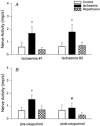Xanthine oxidase, but not neutrophils, contributes to activation of cardiac sympathetic afferents during myocardial ischaemia in cats
- PMID: 12181303
- PMCID: PMC2290482
- DOI: 10.1113/jphysiol.2001.013482
Xanthine oxidase, but not neutrophils, contributes to activation of cardiac sympathetic afferents during myocardial ischaemia in cats
Abstract
Activation of cardiac sympathetic afferents during myocardial ischaemia causes angina and induces important cardiovascular reflex responses. Reactive oxygen species (ROS) are important chemical stimuli of cardiac afferents during and after ischaemia. Iron-catalysed Fenton chemistry constitutes one mechanism of production of hydroxyl radicals. Another potential source of these species is xanthine oxidase-catalysed oxidation of purines. Polymorphonuclear leukocytes (PMNs) also contribute to the production of ROS in some conditions. The present study tested the hypothesis that both xanthine oxidase-catalysed oxidation of purines and neutrophils provide a source of ROS sufficient to activate cardiac afferents during ischaemia. We recorded single-unit activity of cardiac afferents innervating the ventricles recorded from the left thoracic sympathetic chain (T1-5) of anaesthetized cats to identify the afferents' responses to ischaemia. The role of xanthine oxidase in activation of these afferents was determined by infusion of oxypurinol (10 mg kg(-1), I.V.), an inhibitor of xanthine oxidase. The importance of neutrophils as a potential source of ROS in the activation of cardiac afferents during ischaemia was assessed by the infusion of a polyclonal antibody (3 mg ml(-1) kg(-1), I.V.) raised in rabbits immunized with cat PMNs. This antibody decreased the number of circulating PMNs and, to a smaller extent, platelets. Since previous data suggest that platelets release serotonin (5-HT), which activates cardiac afferents through a serotonin receptor (subtype 3,5-HT3 receptor) mechanism, before treatment with the antibody in another group, we blocked 5-HT3 receptors on sensory nerve endings with tropisetron (300 microg kg(-1), I.V.). We observed that oxypurinol significantly decreased the activity of cardiac afferents during myocardial ischaemia from 1.5 +/- 0.4 to 0.8 +/- 0.4 impulses s(-1). Similarly, the polyclonal antibody significantly reduced the discharge frequency of ischaemically sensitive cardiac afferents from 2.5 +/- 0.7 to 1.1 +/- 0.4 impulses s(-1). However, pre-blockade of 5-HT3 receptors eliminated the influence of the antibody on discharge activity of the afferents during ischaemia. This study demonstrates that ROS generated from the oxidation of purines contribute to the stimulation of ischaemically sensitive cardiac sympathetic afferents, whereas PMNs do not play a major role in this process.
Figures






Similar articles
-
Activated platelets contribute to stimulation of cardiac afferents during ischaemia in cats: role of 5-HT(3) receptors.J Physiol. 2002 Nov 1;544(3):897-912. doi: 10.1113/jphysiol.2002.023374. J Physiol. 2002. PMID: 12411532 Free PMC article.
-
Role of 5-HT3 receptors in activation of abdominal sympathetic C fibre afferents during ischaemia in cats.J Physiol. 1998 Jun 15;509 ( Pt 3)(Pt 3):729-40. doi: 10.1111/j.1469-7793.1998.729bm.x. J Physiol. 1998. PMID: 9596795 Free PMC article.
-
Endogenous bradykinin activates ischaemically sensitive cardiac visceral afferents through kinin B2 receptors in cats.J Physiol. 1998 Jul 15;510 ( Pt 2)(Pt 2):633-41. doi: 10.1111/j.1469-7793.1998.633bk.x. J Physiol. 1998. PMID: 9706010 Free PMC article.
-
Reflexes mediated by cardiac sympathetic afferents during myocardial ischaemia: role of adenosine.Clin Exp Pharmacol Physiol. 1996 Aug;23(8):709-14. doi: 10.1111/j.1440-1681.1996.tb01763.x. Clin Exp Pharmacol Physiol. 1996. PMID: 8886495 Review.
-
Cardiac sympathetic afferent activation provoked by myocardial ischemia and reperfusion. Mechanisms and reflexes.Ann N Y Acad Sci. 2001 Jun;940:74-95. doi: 10.1111/j.1749-6632.2001.tb03668.x. Ann N Y Acad Sci. 2001. PMID: 11458709 Review.
Cited by
-
Bradykinin and thromboxane A2 reciprocally interact to synergistically stimulate cardiac spinal afferents during myocardial ischemia.Am J Physiol Heart Circ Physiol. 2010 Jan;298(1):H235-44. doi: 10.1152/ajpheart.00782.2009. Epub 2009 Nov 6. Am J Physiol Heart Circ Physiol. 2010. PMID: 19897709 Free PMC article.
-
Myocardial ischemia-mediated excitatory reflexes: a new function for thromboxane A2?Am J Physiol Heart Circ Physiol. 2008 Dec;295(6):H2530-40. doi: 10.1152/ajpheart.00790.2008. Epub 2008 Oct 24. Am J Physiol Heart Circ Physiol. 2008. PMID: 18952714 Free PMC article.
-
Undiscovered role of endogenous thromboxane A2 in activation of cardiac sympathetic afferents during ischaemia.J Physiol. 2008 Jul 1;586(13):3287-300. doi: 10.1113/jphysiol.2007.148106. Epub 2008 May 15. J Physiol. 2008. PMID: 18483073 Free PMC article.
-
Fundamental hemodynamic mechanisms mediating the response to myocardial ischemia in conscious paraplegic mice: cardiac output versus peripheral resistance.Physiol Rep. 2017 Mar;5(6):e13214. doi: 10.14814/phy2.13214. Physiol Rep. 2017. PMID: 28336819 Free PMC article.
-
Cardiac spinal deafferentation reduces the susceptibility to sustained ventricular tachycardia in conscious rats.Am J Physiol Regul Integr Comp Physiol. 2011 Sep;301(3):R775-82. doi: 10.1152/ajpregu.00140.2011. Epub 2011 Jun 15. Am J Physiol Regul Integr Comp Physiol. 2011. PMID: 21677267 Free PMC article.
References
-
- Amsterdam EA, Pan H-L, Rendig S, Symons D, Fletcher MP, Longhurst JC. Limitation of myocardial infarct size in pigs with a dual lipoxygenase-cyclooxygenase blocking agent by inhibition of neutrophil activity without reduction of neutrophil migration. Journal of the American College of Cardiology. 1993;22:1738–1744. - PubMed
-
- Bednar M, Smith B, Pinto A, Mullane KM. Nafazatrom-induced salvage of ischemic myocardium in anesthesized dogs is mediated through inhibition of neutrophil function. Criculation Research. 1985;57:131–141. - PubMed
-
- Bennett G, Al-Rashed S, Hoult JRS, Brain SD. Nerve growth factor induced hyperalgesia in the rat hind paw is dependent on circulating neutrophils. Pain. 1998;77:315–322. - PubMed
-
- Berger HJ, Zaret BL, Speroff L, Cohen LS, Wolfson S. Cardiac prostaglandin release during myocardial ischemia induced by atrial pacing in patients with coronary heart disease. American Journal of Cardiology. 1977;39:481–486. - PubMed
Publication types
MeSH terms
Substances
Grants and funding
LinkOut - more resources
Full Text Sources
Miscellaneous

